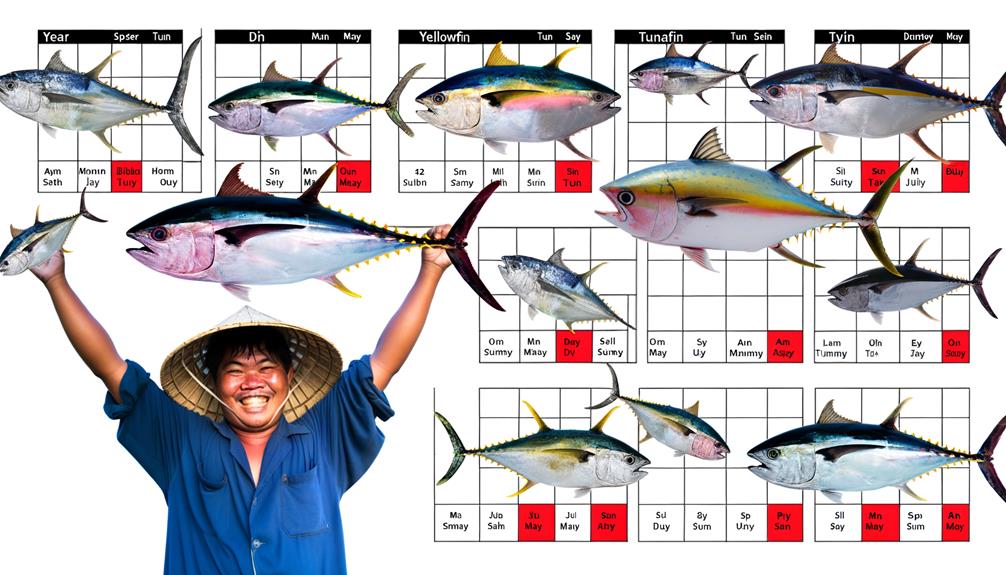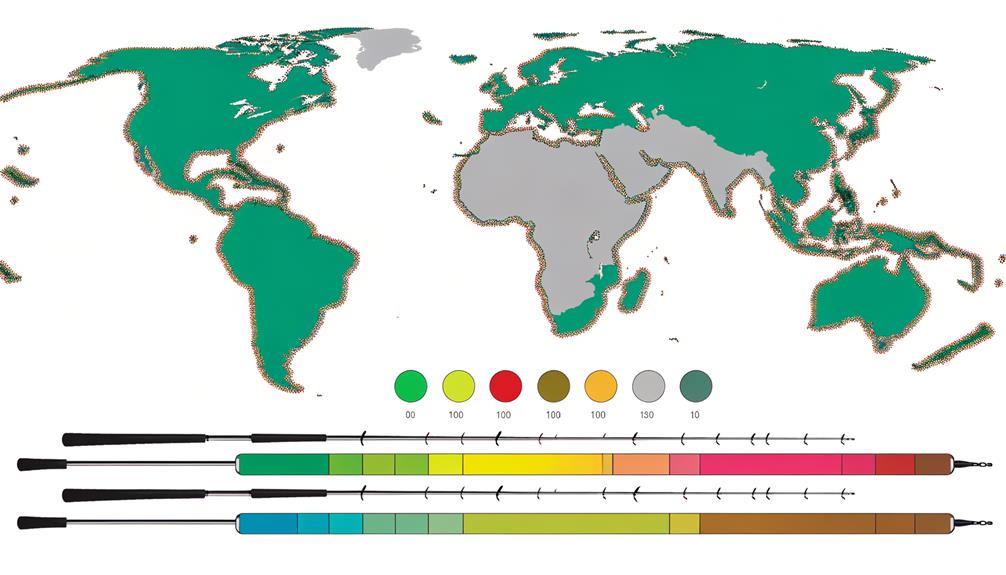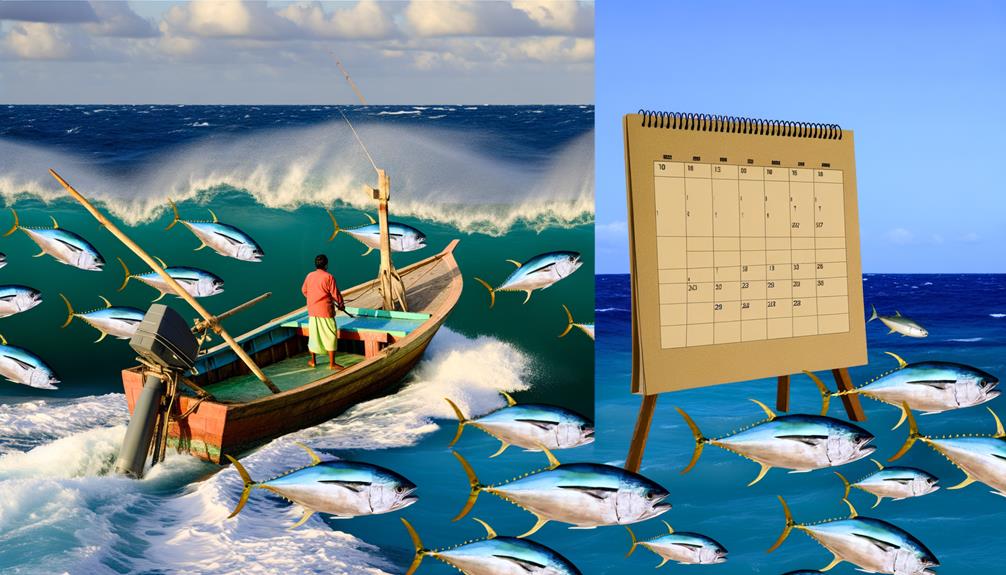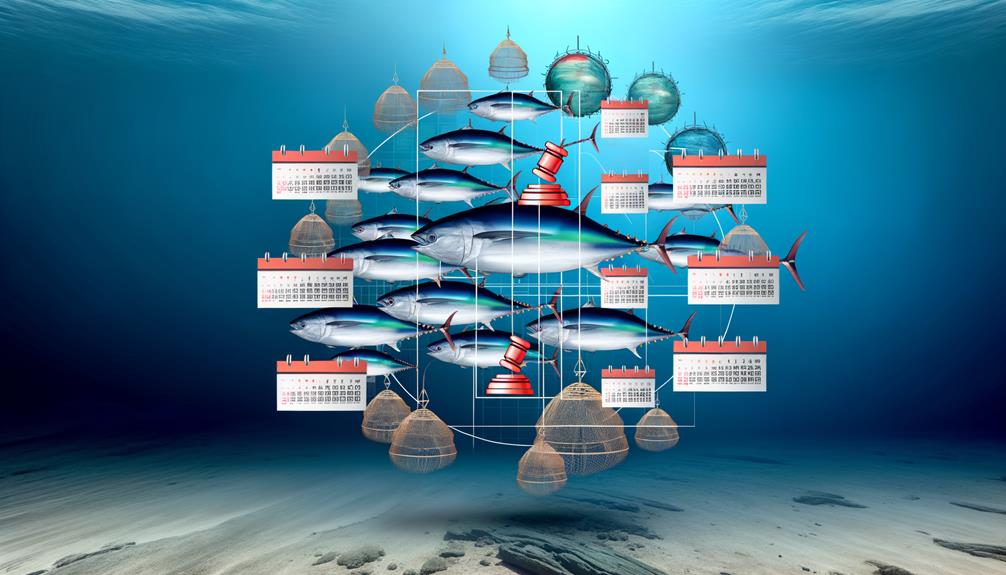Imagine using a sundial to time the tuna season, an old-fashioned method that pales in comparison to the modern tools you have at your disposal today.
Understanding the length of the tuna season is not as straightforward as you may think. It's not simply about marking a date on your calendar. Factors such as location, species of tuna, and even global climate patterns can drastically influence when it's best to cast your line.
But why is it so complex? And how can you navigate these variables to ensure a successful fishing trip?
Let's dive into the depths of this topic and see what we can uncover.
Key Takeaways
- Tuna fishing seasons vary by location, with different U.S. states and international spots offering unique opportunities.
- Understanding variations in tuna seasons is crucial for successful catches and species sustainability.
- Factors such as weather conditions, migration patterns, and state regulations affect the timing and length of tuna seasons.
- Tuna fishing season has economic importance, creating jobs, generating revenue, and attracting tourists to coastal communities.
Understanding Tuna Fishing Season

In order to fully grasp the nuances of tuna fishing season, you must understand that the duration varies greatly by state, heavily influenced by local tuna populations and established fishing regulations.
For instance, in Florida, the tuna season runs from May to September, a period influenced by the migratory patterns and population densities of the species.
Louisiana, on the other hand, offers year-round tuna fishing, a testament to its thriving tuna populations and comparatively lenient regulations. Meanwhile, Texas' tuna fishing season is sandwiched between July and November, reflecting the state's unique marine ecosystem and regulatory environment.
Delaware also provides year-round opportunities for catching yellowfin tuna, a provision that's contingent on the state's specific tuna species and fishery management strategies. As for California, the tuna fishing season varies yearly, typically ranging from April to November, with the best months being during summer.
Washington's albacore tuna fishing season begins in late June and extends until November, with August and September being the most productive months.
Tuna Season in Different U.S. States
While you'll find that each U.S. state has its own unique tuna fishing season, it's crucial to note that these are largely determined by local tuna species, their migratory behaviors, and prevailing fishing regulations.
Different states have different peak seasons, but let's take a look at some examples. In the Gulf of Mexico, which includes states like Texas and Louisiana, bluefin tuna season typically runs from January to June. This is when these giants migrate through the area, providing a thrilling challenge for anglers.
Moving over to the East Coast, particularly in North Carolina and Virginia, you'll find that tuna fishing seasons start around late spring, primarily May, and can stretch until November. These states see a particularly high number of yellowfin tuna during this period.
State to state, it's critical to understand these variations in tuna seasons. Monitoring these shifts can help ensure a successful catch, and more importantly, safeguard the sustainability of the species.
International Tuna Fishing Spots

As you explore the world of international tuna fishing, it's essential to understand the top locations and their seasonal catch patterns.
From the warm currents of the Pacific to the deep, cold waters of the Atlantic, each region presents unique opportunities for tuna fishing.
Detailed analysis of these patterns can significantly improve your catch rates and offer unique insights into this global fishery.
Top Tuna Fishing Locations
Diving into the depths of international tuna fishing, you'll find that the tuna season varies by location, providing year-round opportunities in some areas while others have specific prime fishing months. As you explore the top tuna fishing locations, you'll discover that each location has its unique offerings.
- In the fishing capital of Florida, the tuna season is abundant from May to September, although hurricanes may impact this.
- Hawaii, with its diverse tuna species, offers prime fishing from May to September.
- Louisiana provides year-round tuna fishing, with the recommended months being from January to March.
The variety of tuna species in Texas and the fishing opportunities from July to November make it another top destination for tuna fishing. Joining this community will enhance your knowledge and fulfill your desire for belonging.
Seasonal Tuna Catch Patterns
Navigating the international waters of tuna fishing, you'll notice that seasonal catch patterns can vary significantly depending on the location and targeted species. In the North American region, for instance, bluefin tuna fishing occurs mainly during summer and fall, while yellowfin tuna is available year-round in warmer waters.
Techniques like trolling, chunking, jigging, and live bait fishing are used to capitalize on these patterns. Understanding the season and the associated tuna catch patterns can greatly enhance your success as a fisher.
Federal regulations, managed by the National Marine Fisheries Service, govern tuna season to ensure sustainable practices. It's crucial to comprehend these regulations to ensure compliance and promote sustainability in our shared quest for the perfect tuna catch.
Bluefin Tuna Season Overview
When you're targeting bluefin tuna, it's important to note that the season can vary significantly based on location, ranging from year-round opportunities in places like Louisiana to more specific durations in regions such as Florida, Texas, Hawaii, Washington, California, and New England. Understanding these variations is crucial to plan your trips and successfully catch bluefin tuna.
To give you a bluefin tuna season overview, let's dive into more details:
- Florida and Texas have opportunities from May to September, with the peak season occurring in the warmest months.
- Hawaii's bluefin tuna season lasts from May to September, with the best chances between June and August.
- In Washington, the season runs from late June to November, with August and September being the most promising months.
Atlantic Vs Pacific Tuna Season

You'll find that the Atlantic bluefin tuna fishing season, which runs from June to November, contrasts with the Pacific bluefin tuna season, generally starting in May and ending in October.
However, it's not just the timings that differ – the species-specific seasonal variations also play a significant role.
For instance, the restrictions in the Atlantic aim to protect the species, while the Pacific coast offers an open season for recreational anglers.
Season Length Differences
Examining the Atlantic and Pacific tuna seasons reveals notable differences in their duration and timing, largely influenced by geographical and climatic variations. To understand how long is tuna season and the season length differences, it's essential to consider the region and species of tuna.
- Atlantic bluefin tuna season typically runs from June to November. Your next fishing adventure could be along the Eastern North American seaboard during these best months.
- Pacific bluefin tuna, on the other hand, are generally caught off the coast of California between May and October.
- Locations like Louisiana allow for tuna fishing year-round, with peak months being January to March.
These variations underline the importance of aligning your fishing trips with the specific tuna seasons to maximize your catch.
Species-Specific Seasonal Variations
Diving into species-specific seasonal variations, it's crucial to note that Atlantic bluefin tuna and Pacific bluefin tuna seasons differ considerably, largely dictated by the geographical location and climatic conditions of their habitats.
Atlantic bluefin tuna can be found from June to November along the Eastern North American seaboard, whereas Pacific bluefin tuna season is typically from May to October off the coast of California.
The length of these species of tuna seasons varies, but it's important to know when and where to find each type. Understanding how long is tuna season for each species allows you to partake in responsible and sustainable fishing practices.
This knowledge not only enhances your fishing experience but also contributes to the conservation of these magnificent species.
Factors Affecting Tuna Season
Let's delve into the various factors that shape the duration of the tuna season, bearing in mind that everything from local weather and migration patterns to state regulations plays a significant role.
Weather conditions influence the presence of tuna in certain areas. For instance, the warm-blooded nature of tuna allows them to stay active in lower temperatures, which in turn has implications for when you can start fishing.
Migration patterns also determine the timing and length of tuna season. If the feeding grounds favorable for tuna are far off, you might need to wait longer before catching tuna becomes feasible.
State regulations are another critical factor affecting tuna season. These rules aim to sustain tuna populations and prevent overfishing. They might dictate when, where, and how much tuna you can fish.
To sum up, the key factors affecting tuna season are:
- Weather conditions and tuna's ability to thrive in lower temperatures
- Tuna migration patterns and the location of feeding grounds
- State regulations designed to maintain sustainable tuna populations
Understanding these factors will help you better plan your tuna fishing endeavors and contribute to the preservation of this valuable marine species.
The Impact of Tuna Fishing Regulations

Navigating the intricacies of tuna fishing regulations, you'll discover they've a profound impact on maintaining sustainable tuna populations and preventing overfishing. These regulations, defined by government agencies, aren't just legal mumbo jumbo; they're critical for preserving species such as yellowfin.
Catch limits, for instance, are carefully calculated for both commercial and recreational fishermen to balance the impact of tuna fishing with the rate of reproduction of these fast, powerful fish. Overshooting these limits can lead to a devastating drop in the tuna population, disrupting the balance of our oceans.
Size restrictions further protect young tuna, ensuring they've the opportunity to mature and reproduce. This means you're less likely to haul in a baby yellowfin, but you're helping to secure the future of the species.
Seasonal closures and licensing requirements may seem a nuisance, but they're crucial protective measures. By limiting when and who can fish, these regulations help to safeguard spawning grounds and maintain a healthy, thriving ecosystem.
The Economic Importance of Tuna Season
While understanding the protective measures and regulations of tuna fishing is crucial, it's equally important to consider the economic significance of the tuna season. Let's delve into how the length of the tuna season impacts the economy.
- Job Creation: Tuna fishing is a major employment driver in coastal communities. Depending on how long the tuna season lasts, it can create a significant number of jobs ranging from fishing to processing and distribution.
- Revenue Generation: Tuna is a high-value fish, and the sales contribute substantially to the local and national economy. The longer the season, the higher the revenue generated.
- Tourism Boost: Tuna fishing attracts tourists, and a lengthier season can draw more visitors, boosting local businesses and hospitality sectors.
It's fascinating to note the ripple effect of the tuna season's duration on various economic sectors. Different tuna species, each with their Rights Reserved, contribute uniquely. The economic importance of the tuna season is indeed a testament to the interconnectedness of industries and the environment.
Frequently Asked Questions
How Long Is the Tuna Season on Wicked Tuna?
On 'Wicked Tuna', the season's length depends on the show's production, crew lifestyle, conservation efforts, and filming challenges. It's not solely about tuna season, but the complexities of capturing it on screen for you.
How Long Is Tuna Season Outer Banks?
In the Outer Banks, you'll find tuna season lasts from November to May. It's regulated carefully, considering tuna migration patterns and the local ecology, to ensure sustainable fishing and protect this vital resource.
How Much Does a Tuna Fisherman Make a Year?
Your income as a tuna fisherman can greatly vary. It's influenced by factors like catch size, market rates, and equipment costs. Understandably, this unpredictable earning potential can greatly impact your lifestyle.
How Long Is Bluefin Tuna Season in Massachusetts?
You're inquiring about bluefin tuna season in Massachusetts, aren't you? It runs from early June through November, but it's weather-dependent. Remember to adhere to bluefin regulations and local fishing laws. Happy fishing!
Conclusion
So, you've sailed through the vast oceans of knowledge on tuna seasons. Remember, from Florida's warm waters in May to Hawaii's peak season from June to August, each state writes its own fishy tale.
Don't forget, the world is your oyster—or should I say, your tuna can! Always keep your eyes on local regulations and environmental factors.
Tuna fishing isn't just a sport, it's an art that paints a significant picture on our economy's canvas.
